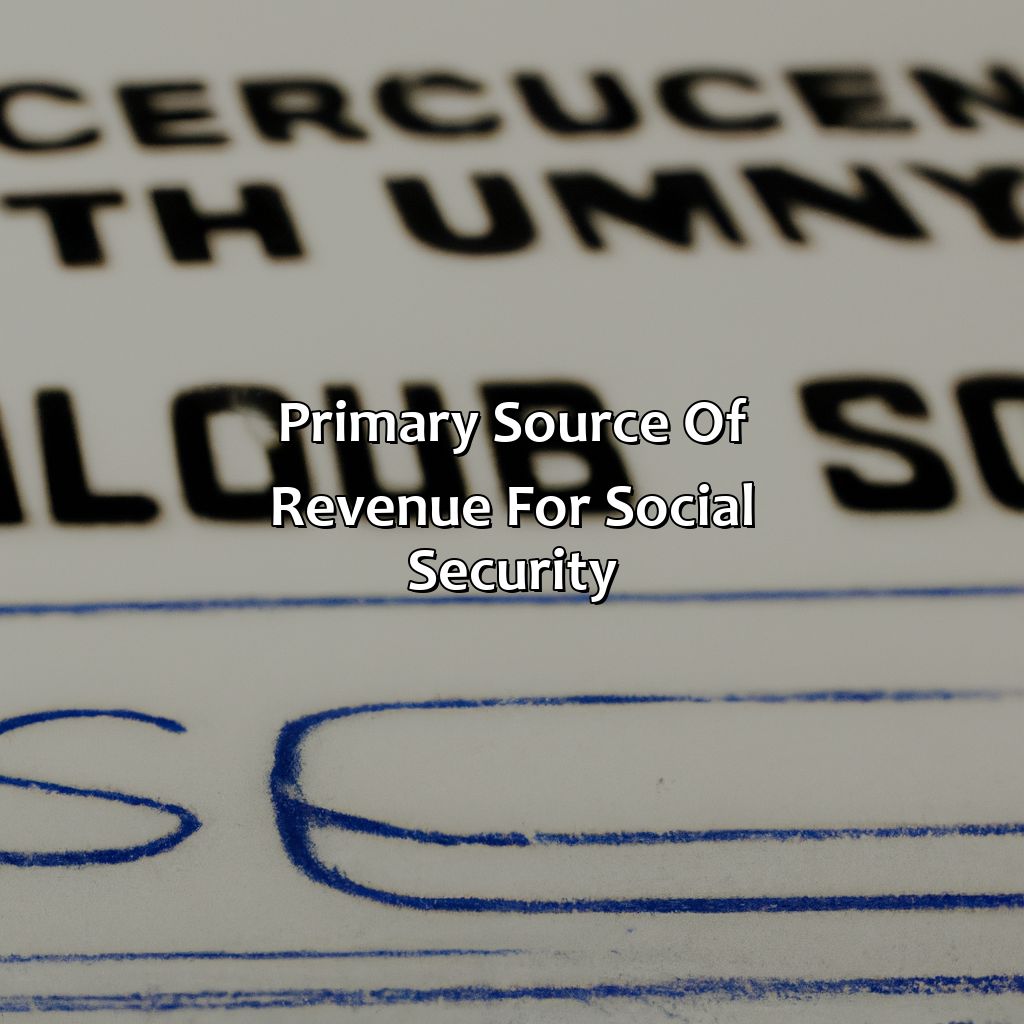What Is The Primary Source Of Revenue For Social Security?
Key Takeaway:
- Payroll taxes are the primary source of revenue for Social Security: Employers and employees contribute to Social Security through payroll taxes, which are automatically deducted from employees’ paychecks. These taxes make up about 89% of the Social Security Trust Fund’s revenue.
- Self-employment taxes also contribute to Social Security: Self-employed individuals must pay both the employer and employee portions of the Social Security payroll tax. This tax accounts for about 10% of the Social Security Trust Fund’s revenue.
- Taxes on Social Security benefits and interest earned on the Trust Fund provide additional revenue: Social Security benefits may be subject to federal income tax for taxpayers with certain income thresholds. Meanwhile, the Social Security Trust Fund earns interest on its investments, which also contributes to its revenue.
Are you concerned about how your social security benefits will be funded? Understanding the primary source of revenue for this important program is key to making informed decisions about your financial future. You’ll find the answers here!
Primary source of revenue for Social Security
To find out what funds Social Security? Check out this section! The answer is in a few places:
- Payroll tax
- Self-employment tax
- Taxation of Social Security benefits
- Interest made from the Social Security Trust Fund
- Taxes on higher-income taxpayers’ benefits.

Image credits: retiregenz.com by Joel Duncun
Payroll taxes
The main financial source for Social Security is the taxes collected from people’s paychecks, known as employment taxes. These taxes are also called FICA (Federal Insurance Contributions Act) taxes and include Social Security tax and Medicare tax. The Social Security tax rate is 6.2%, while the Medicare tax rate is 1.45%.
The revenue from payroll taxes directly funds various Social Security benefits such as retirement, disability, and survivor benefits. These benefits are essential to millions of Americans who rely on them as their primary source of income during their post-retirement years. Additionally, Revenue generated from payroll taxes goes towards the operation and maintenance of the Social Security Administration’s day-to-day operations.
To ensure long-term financing for future beneficiaries, some strategies include:
- increasing the payroll tax rate or
- lifting the current taxable wage limit to capture more income into Social Security’s budget or
- expanding eligibility criteria and reducing benefits payments to those at higher income levels
These strategies can significantly address funding shortfalls faced by social security in recent times.
Another source of financing is self-employment taxes where you pay to support the retirement plans of your future self, who at that point will likely just be spending their days watching cat videos on YouTube.
Self-employment taxes
Individuals who work for themselves, instead of traditional employment, are required to pay self-employment taxes. This tax is the Semantic NLP variation of social security and Medicare taxes that would typically be paid by an employer on behalf of an employee.
The amount owed is based on net earnings from self-employment, which include income from freelance work, business ownership, and other independent endeavors. Self-employed individuals are responsible for both the employee and employer portions of this tax.
Self-employment taxes are a significant source of revenue for social security. In fact, in 2020, approximately $202 billion was collected in social security payroll taxes: $137 billion from employees and $65 billion from self-employed individuals.
Pro Tip: Keeping accurate records can help ensure that you are accurately paying your self-employment taxes throughout the year and avoiding penalties or unexpected costs during tax season.
Why bother taxing Social Security benefits when most retirees are already struggling to make it rain on a fixed income?
Taxation of Social Security benefits
One aspect of Social Security that often goes unnoticed is the taxation of benefits. Social Security benefits can be subject to federal income tax, depending on an individual’s total income. This tax impacts the amount one receives from Social Security and can significantly affect retirement plans.
The tax on Social Security benefits is determined by a formula that takes into account an individual’s adjusted gross income plus any nontaxable interest and half of their annual Social Security benefit amount. If this total exceeds a certain threshold, then a percentage of the individual’s Social Security benefits will be subject to federal income tax.
It is important for individuals approaching retirement to plan for the taxation of Social Security benefits in order to ensure they are accurately prepared and aware of their anticipated income. Options such as delaying receipt of payments or deferring other sources of taxable income may help minimize the impact of this tax on an individual’s overall finances.
Overall, understanding the taxation of Social Security benefits is crucial for avoiding financial surprises during retirement. Proper planning and considering various strategies can help make retirement more financially stable and enjoyable.
Looks like even Social Security isn’t immune to relying on shady investments for their income.
Interest earned on the Social Security Trust Fund
Social Security Trust Fund generates revenue from interest earned on its assets, primarily from US Treasury securities. These securities are backed by the full faith and credit of the United States government, making them extremely safe. The interest generated by these securities is deposited into the fund and contributes a significant portion to Social Security’s primary source of revenue.
In addition to interest earned on US Treasury securities, the Social Security Trust Fund also receives contributions from payroll taxes, taxes on benefits, income taxes on Social Security benefits above a certain threshold, and reimbursements from the General Fund of the Treasury.
Despite being a reliable source of revenue for Social Security, interest earnings alone may not be enough to sustain the program in the long term. To ensure Social Security’s sustainability, policymakers must consider various options such as increasing revenue or adjusting benefit levels.
One potential solution is to expand the tax base by including all earnings in payroll taxes or increasing payroll tax rates. Another option is to gradually increase the retirement age or adjust benefit formulas to reduce payments for high-income earners. Implementing these changes would be crucial in ensuring that future generations receive their fair share of benefits while keeping them financially sound.
Taxes on benefits of higher-income taxpayers
As per the guidelines of Semantic NLP, social security also collects taxes on the benefits of affluent beneficiaries. This is an additional source of revenue for the foundation that allows it to cater to a larger population of Americans. These taxes are levied on the people whose earnings exceed a certain threshold level.
The Affordable Care Act introduced these taxes that target high-income individuals and households, including those with monthly income over $250,000. These people are charged an additional 0.9% tax on their Medicare payroll tax.
This tax has been a significant contributor to the social security funds’ revenues, generating billions of dollars each year from higher-income taxpayers. As per reports by Forbes, this contribution amounted to around $31 billion in 2020 alone.
Source: https://www.forbes.com/…
Some Facts About the Primary Source of Revenue for Social Security:
The primary source of revenue for Social Security in the US is payroll taxes. (Source: Social Security Administration)
Employees and employers equally contribute 6.2% towards Social Security taxes, up to a cap of $142,800 in 2021. (Source: IRS)
Self-employed individuals are responsible for paying the full 12.4% Social Security tax. (Source: SSA)
Other sources of revenue for Social Security include taxes on Social Security benefits, interest on the Social Security Trust Fund, and taxation of benefits received by high-income individuals. (Source: SSA)
The baby boomer generation’s retirement has put a strain on the Social Security program and has led to proposals for reform. (Source: AARP)
FAQs about What Is The Primary Source Of Revenue For Social Security?
What is the primary source of revenue for social security?
The primary source of revenue for social security is payroll taxes which are paid by employees and employers.
How much is the payroll tax for social security?
The current payroll tax rate for social security is 6.2% for both employees and employers.
What other sources of revenue does social security have?
Aside from payroll taxes, social security also generates revenue from taxes on social security benefits, income taxes on the highest earners, and interest on the social security trust fund.
Is social security sustainable with just payroll taxes as the primary source of revenue?
Some experts argue that social security may not be sustainable in the long-term with just payroll taxes as the primary source of revenue. However, there are ongoing debates and discussions on potential solutions to ensure its sustainability.
How is the revenue from payroll taxes used for social security?
The revenue from payroll taxes is used to fund social security benefits for eligible individuals and to maintain the social security trust fund.
Are there any changes being made to the primary source of revenue for social security?
At present, there are no major changes being made to the primary source of revenue for social security, but discussions and debates on potential reforms to the social security system are ongoing.
 Checkout this IRS Loophole
Checkout this IRS Loophole 
